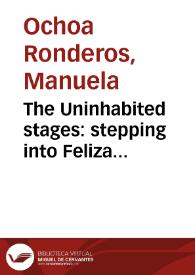The Uninhabited stages: stepping into Feliza Bursztyn’s house = Los escenarios inhabitados:...
Contenido de la obra
Contenido de la obra
Registro bibliográfico
Registro
- Título: The Uninhabited stages: stepping into Feliza Bursztyn’s house = Los escenarios inhabitados: entrar a la casa de Feliza Bursztyn
- Autor: Ochoa Ronderos, Manuela
- Publicación original: 2013
- Descripción física: PDF
-
Notas generales:
- Bogotá (Colombia)
-
Abstract:
Through a fragmented and asynchronous narrative, this project analyzes three spaces inside the Bogotá house of the Colombian artist Feliza Bursztyn (1933-1982): her husband’s room or the archive, the garden and the studio. A pioneer of installation art, or environmental spaces in Latin America, Bursztyn worked with unconventional materials such as scrap metal, ragged fabrics, stainless steel and machine engines to create sculptures accompanied by sound, movement, lights and short films. She was an active member of Bogotá’s intellectual spheres, and was part of their discussions and thoughtful criticism on the Colombian social and political context from 1960 to 1980. After being persecuted and criminalized by the Colombian government Bursztyn left the country and died in Paris in 1982. Her presence in the art scene was brief and her importance in Latin American – not to mention global – art history is barely mentioned. Therefore, her work and her figure remain a quizzical and ungraspable object of study. This research will discuss spaces, people, animals and objects inside her house, an uninhabited place working as a private and complex archive through the contradictions and the unwritten layers of knowledge that vibrate within.
Resumen:
Este ensayo es una narración fragmentada y asincrónica. Contiene tres espacios dentro de la casa de la artista colombiana Feliza Bursztyn (1933-1982): el cuarto de su marido o el archivo, el jardín y el taller. Pionera de la instalación, o de los espacios ambientales en América Latina, Bursztyn trabajó con materiales no convencionales, como la chatarra, telas rasgadas, acero inoxidable y motores para crear esculturas acompañadas de sonido, movimiento, luces y cortometrajes. Fue miembro activo de las esferas intelectuales de Bogotá e hizo parte de las discusiones y críticas sobre el contexto social y político colombiano entre 1958 y 1981. Después de ser perseguida y criminalizada por el gobierno colombiano, Bursztyn abandonó el país y murió en París en 1982. Su presencia en la escena artística fue breve y su importancia en la historia del arte latinoamericano- por no decir mundial - apenas se menciona. Este texto analizará los espacios, personas, animales y cosas dentro de su casa, un lugar inhabitado que funciona como un archivo privado y complejo, con contradicciones y capas de conocimiento que no están escritas.
- Notas de reproducción original: Digitalización realizada por la Biblioteca Virtual del Banco de la República (Colombia)
-
Notas:
- Resumen: Sculpture; Colombian art; Feminism; 1970; Escultura; Arte colombiano; Feminismo
- © Derechos reservados del autor
- Colfuturo
- Forma/género: tesis
- Idioma: inglés
- Institución origen: Biblioteca Virtual del Banco de la República
-
Encabezamiento de materia:
